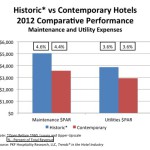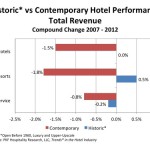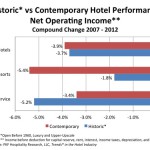
Industry thumb rules state that the ?useful life? of a hotel ranges from 30 to 40 years. After that the building and its equipment are either too old to renovate, or the property is no longer situated in a prime location. However, for a few hotels in the United States that are 50 years old, or more, they are just hitting the prime of their life. These ?grande dames? are achieving premium occupancy and ADR levels compared to comparable youngsters.
To check up on the health of these aging facilities, PKF Hospitality Research, LLC (PKF-HR) analyzed the performance of historic luxury and upper-upscale hotels that opened prior to 1960 (e.g. Waldorf Astoria and The Greenbrier).? Comparisons were made to the performance of comparable luxury and upper-upscale properties built since 1960.? Only hotels that provided data for PKF-HR?sTrends? in the Hotel Industry?survey each year from 2007 through 2012 (most current annual data available) were included in the study sample.
The study sample consisted of 41 historic hotels with an average age of 94.2 years, and an average size of 388 rooms.? Eleven of the 41 historic properties are resorts, with the remaining urban/suburban full-service hotels. ?The contemporary sample averaged 22.9 years in age, and averaged 417 rooms.? Fifty-six of the newer hotels were resorts, while another 282 were full-service properties.
Revenue Premiums
In 2012, the average historic hotel in our sample achieved an occupancy level of 74.0 percent.? This compares favorably to the 73.3 percent aggregate occupancy of contemporary sample.? The occupancy premium was greater for the historic resort hotels, versus the full-service urban/suburban properties.
Despite the fact that both the historic and contemporary samples consisted of properties in the luxury and upper-upscale categories, we observed some significant differences in the average daily room rates (ADR) achieved in 2012.? During that year, the historic hotels averaged an ADR of $236.94, a 23.5 percent premium over the $192.07 ADR for the contemporary sample.
Contrary to the relative occupancy performance, the ADR premium associated with the historic hotels was driven by the performance of the full-service hotels.? In 2012, the historic full-service properties achieved an ADR of $241.28 which is 30.9 percent greater than the $184.39 ADR for the contemporary full-service hotels.? Conversely, the ADRs of both resort samples were roughly $229 dollars.? It appears that the greatest competitive advantage of the urban/suburban historic hotels is achieved through significant ADR premiums.
Costly Operations
While the historic hotels in the study sample achieved market performance premiums, lower profit margins indicate that these hotels are somewhat less efficient to operate.? In 2012, the average profit margin for the historic hotels was 21.0 percent, while the contemporary hotels were able to bring 24.6 percent of their revenue to the bottom-line.? For the purposes of this analysis, profits are defined as net operating income (NOI) before deductions for capital reserve, rent, interest, income taxes, depreciation and amortization.
The majority of efficiency appears to be lost in the operating departments of the historic hotels.? These departments (rooms, food and beverage) are very labor intensive.? Older buildings typically lack service elevators and storage rooms, as well as long hallways.? Further, it can be assumed that these physical attributes contribute to relatively high staffing levels, and operational inefficiencies.? In 2012, total departmental expenses averaged 48.4 percent of total revenue at the historic hotels.? Concurrently, the contemporary properties achieved a departmental expense ratio of just 43.9 percent.
The age of the buildings also contributed to greater than average maintenance and utility expenditures.? In 2012, maintenance expenditures measured on a dollar-per-available room basis were 41 percent higher at the historic hotels, while energy costs were 31.8 percent higher.? Fortunately, because of the revenue premiums, both the maintenance and utility department expense ratios (to total revenue) at the historic hotels equaled similar ratios at the contemporary properties.
Experience And Wisdom
They say that with age comes experience and wisdom.? It appears that this philosophy applies equally to humans, and hotels.? During the period 2007 through 2012, the ?experience? of the older properties helped them weather the recession a bit better than their younger competitors.
As of year-end 2012, total revenue levels at the historic hotels had recovered to pre-recession levels.? Conversely, for the contemporary properties, 2012 total revenues were still 7.4 percent below 2007 levels.
Despite recovering quicker on the top-line, historic hotels struggled equally on the bottom-line.? The 2012 NOI levels at both the historic and contemporary hotels were roughly 17 to 18 percent below their pre-recession peaks achieved in 2007.? Hindering the performance of the historic properties during the six year cycle was an annual growth rate in expenses more than two times greater than the change in costs at the contemporary hotels.
No Sunset In Sight
Based on the June 2014 edition of?Hotel Horizons?,?PKF-HR is forecasting occupancy levels for both the luxury and upper-upscale lodging segments to remain above 70 percent through 2018. ?This will allow for healthy gains in ADR as well.? Given the strong recent performance of the historic hotels, it does not appear that these nonagenarian properties will be riding off into the sunset anytime soon.
Robert Mandelbaum is Director of Research Information Services for PKF Hospitality Research, LLC.? He is located in the firm?s Atlanta office (www.pkfc.com).? To benchmark the financial performance of your hotel, please visit?www.pkfc.com/benchmarker.? This article was published in the May 2014 issue of Lodging.





